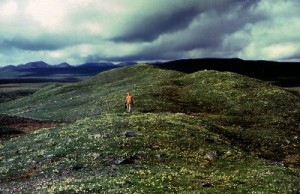Paying it Forward

“The child is father to the man.”
That’s me in the orange safety vest, walking on a glacial moraine in the northern foothills of the Brooks Range, Alaska. I’m there to provide a scale for the photograph, which was one of my most frequent tasks as a field assistant when working in this treeless world during the 1974 and 1975 “field seasons” with my boss, U.S. Geological Survey geologist Thomas D. Hamilton. We worked six days a week via helicopter-assisted foot traverses to map the surficial materals of the Chandalar, Phillip Smith, Itkillik, and Sagivinirktok quadrangles (each 2-degrees longitude) at a scale of 1:250,000, each the size of southern New England.
It was Hamilton who took this photograph. He had been my M.S. graduate advisor at the University of Alaska, though he left midway through my program to join the U.S. Geological Survey. Three decades later, another geologist named Rod Combellick, published Hamilton’s photo as the cover image for Professional Report 121 of the Alaska Division of Geological & Geophysical Surveys (2003). I had been Rod’s M.S. graduate advisor at the University of Alaska, where I taught from 1980-1984 in Hamilton’s former position. In this case, the academic “grandfather” (Hamilton) benefited by having a photo of his academic “son” (Thorson) published by his academic “grandson” (Combellick).
Behind the scenes is a fourth generation of academic mentorship. During the late 1960s, a geologist named Robert Black was teaching at the University of Wisconsin in Madison. There, he served as the M.S. graduate advisor for Thomas Hamilton, who had originally hailed from Essex, Connecticut. In 1973, Black moved from Wisconsin to the University of Connecticut. Ten years later, in 1983, he attended a workshop on glacial geology that Hamilton and I had organized at Chena Hot Springs, Alaska. When I was driving Black back to Fairbanks to catch his flight, Black strongly encouraged me to apply for his his job at the University of Connecticut if and when he retired. A few months later, Black died unexpectedly just before returning to the University of Connecticut after his year-long sabbatical. Simultaneously, my wife and I were deciding to move southward for better opportunities for our first born son with profound autism and cerebral palsy. Shortly after the published deadline, I happened to notice that the University of Connecticut was re-filling Black’s position. Naturally, I applied, and luckily, I was hired to replace him. When cleaning and converting Black’s former office-lab to suit my needs, I found on one of his bookshelves an original typewritten copy of Tom Hamilton’s master’s thesis (as well as one from Robert Palmquist, who taught me field geomorphology during my field school experience at Iowa State University in 1971). I hand-delivered that thesis back to Hamilton as a gesture of appreciation for his mentorship.
In this story, the academic “great grandfather” (Black), bequeathed to the “grandson” (Thorson), something to bequeath his academic “son” (Hamilton), who, by then, had become the “grandfather” of Combellick, his publisher.
Mentorship is the gift that keeps on giving.
Photo by Thomas D. Hamilton with Robert Thorson’s camera. See text above.